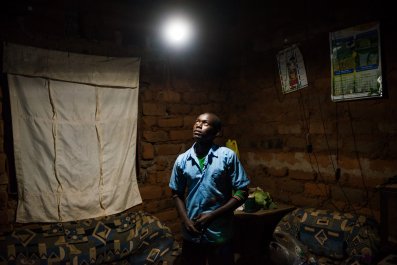
Anika Crenshaw planned on a vaginal birth for her second child, as she had done with her daughter a few years earlier. But soon after she arrived at the hospital in 1998, she began experiencing some light bleeding, and a nurse entered the room with a razor and a catheter and told Crenshaw she was about to undergo a cesarean section.
"It just happened so fast," Crenshaw says. "It was very traumatic. No one explained anything to me about the procedure or the risks. It wasn't an emergency, but they just threw some papers at me and said I had to sign them. When I woke up, I felt horrible. Physically unstable and emotionally dead." It got worse: Crenshaw contracted an infection, and recovery took months.
Seven years later, when giving birth to her third child, she underwent another C-section, and again said she felt "duped." When she became pregnant with her fourth in 2013, she decided to try a home birth to avoid the hospital.
Mortality rates' racial divide
Crenshaw was one of the 60,000 women a year in the U.S. who experience near-fatal complications during pregnancy and childbirth, and these women are the fortunate ones—about 1,200 more die. Even more troubling is that despite tremendous advances in medicine in recent decades, maternal mortality rates in the U.S. have more than doubled over the past 25 years. That trend puts the U.S. in the same category as Afghanistan, Belize and South Sudan. In fact, the U.S. is the only developed country with rising mortality rates, according to the University of Washington's Institute for Health Metrics and Evaluation. Save the Children ranks the U.S. 61st in the world when it comes to maternal health —despite the fact that the U.S. spends more than every other country on Earth on health care and more on childbirth-related care than any other area of hospitalization.
The shameful secret is that even when controlling for age, socioeconomic status and education, the U.S. Centers for Disease Control and Prevention (CDC) reports that African-American women, like Crenshaw, face a nearly four times higher risk of death from pregnancy complications than white women. In parts of the U.S. with high concentrations of women of color who live in poverty, such as Mississippi, maternal death rates can surpass those of sub-Saharan Africa .
There are plenty of reasons why. One is simple: Women of color as a demographic have poorer health than white women and are therefore more likely to have high-risk pregnancies. While the incidences of hemorrhage, infection and pre-eclampsia—which have long been the leading causes of maternal death —are dropping, the proportion of maternal deaths from cardiovascular diseases and cardiomyopathy are climbing, now representing over one-quarter of pregnancy-related deaths, according to the CDC. And, says Dr. Michael Lu, the associate administrator for maternal and child health at the Health Resources and Services Administration, more and more women are entering pregnancy with chronic conditions, like hypertension, diabetes and obesity, that disproportionately affect poor and minority populations. For example, one study out of University of California, Davis, revealed that people with a lower socioeconomic status face a 50 percent greater risk of developing heart disease than other study participants.
Another factor is the marked inequalities across racial and socioeconomic lines when it comes to accessing family planning services. Women who have children too close together face increased risk of complications, and research from the University of California, San Francisco, found that minority and low-income women face greater barriers to contraception, which contributes to higher rates of unintended, and thus higher-risk, pregnancies.
Moreover, women with unplanned pregnancies are more likely to delay prenatal care, and the CDC estimates that women who receive no prenatal care are three to four times more likely to die of pregnancy-related complications than women who do, and women with high-risk pregnancies are five times more likely to die if they do not receive prenatal care. Again, there are clear demographic demarcations. "African-American and Latina women are about 2.5 times more likely to get delayed prenatal care than a white woman," says Rachel Ward, a senior director of research at Amnesty International, who co-authored a report titled " Deadly Delivery: The Maternal Health Care Crisis in the USA ."
Low-income women, women of color and immigrant women are more likely to be uninsured. Medicaid finances nearly half of all births in the U.S., but accessing quality prenatal care on Medicaid can be prohibitively difficult. "If you are eligible for Medicaid, there are still delays in bureaucracy and hurdles to getting access," says Ward. "Women who receive Medicaid have said that there are only so many doctors willing to accept them as patients. It takes time to find a doctor, and the longer you leave it in pregnancy, the less likely it is that a doctor will take you on."
Logistical problems create challenges, as well. A 2013 survey from the Kaiser Family Foundation found that poor women are typically unable to get time off work, arrange transportation to clinics and find someone to watch their kids. Inflexible appointment hours and an absence of information in languages other than English create further obstacles.
Perhaps most distressing, racial and socio-economic factors also have a disproportionate effect on the quality of care mothers receive during childbirth. A report titled "Discrimination and Racial Disparities in Health" from the Harvard School of Public Health found that bias, prejudice and stereotyping by health care providers contribute to delivering lower-quality care—affecting how mothers are treated during childbirth and the outcomes. "Assumptions are made about you when you walk through the door, based on how you walk, how you dress, whether you sound educated or not," says Chanel Porchia-Albert, founder and executive director of the Brooklyn-based Ancient Song Doula Services. "That affects the level of support you get."
Too many cesarean sections
Variations in the way patients are treated can have deadly consequences. Perhaps the most salient manifestation of this is the incidence of cesarean deliveries. The World Health Organization considers the "ideal rate" for cesarean sections to be between 10 and 15 percent. In the U.S. today, one in three women who give birth has a cesarean delivery. But it hasn't always been that way; the rate of cesarean deliveries increased rapidly in the U.S. between 1996 and 2011, leading the American College of Obstetricians and Gynecologists to publish a paper in 2014 stating that cesarean deliveries are overused and often unwarranted.
In many cases, as in Crenshaw's, a C-section is not presented as a choice, nor are women adequately informed about the risks. The 2013 Listening to Mothers survey from the National Partnership for Women and Families revealed that almost two-thirds of mothers undergoing their first cesarean indicated the doctor was the decision-maker. Many respondents said they felt pressure from a health professional to have an intervention—and measures, such as inducing labor, can lead to a "cascade of intervention" that results in a cesarean.
Certain demographics are more vulnerable to these kinds of pressures than others. Research at the University of Arizona has found that minority women, women with low socioeconomic status and women with less education generally have less power with their care providers. As a result, they are more likely to have unwarranted cesarean deliveries. Conversely, "women with racial and socioeconomic advantages use them to avoid medically unnecessary cesarean deliveries."
"What's really behind a lot of it is racism," says Jennie Joseph, a midwife who founded Commonsense Childbirth, a birth center in central Florida. And inequalities in treatment lead to alarming inequalities in outcomes. Evidence from the CDC revealed that 46 percent of maternal deaths among African-American women were potentially preventable, compared with 33 percent of such deaths among white women. And among women diagnosed with pregnancy-induced hypertension, African-American and Latina women were, respectively, 9.9 and 7.9 times more likely to die than white women with the same complications.
There are measures that states, hospitals and care providers can adopt to directly close gaps in mortality and deliver better care. Last year, the Alliance for Innovation on Maternal Health, a national coalition of more than 20 organizations that do childbirth-related work, launched an initiative to prevent maternal deaths over the next four years by disseminating "safety bundles" to institutions with birth facilities. The packets include resources for dealing with severe hypertension and obstetric hemorrhage, as well as a framework for reducing unnecessary cesarean deliveries. During a pilot program with the safety bundles in California, the maternal mortality rate per 100,000 live births decreased from 16.9 to 6.2 over the course of six years. "Many of these maternal deaths and severe morbidities are preventable," Lu says. "The safety bundles go after lower-hanging fruit." The goal, he says, is simply to help obstetrics catch up to the best science.
However, greater standardization stands to improve only half the equation. The fact remains that the women who face the highest risk of complications are those most likely to receive lower-quality care, leading many women of color, including Crenshaw, to the conclusion that the best opportunities for equality exist outside of the mainstream health care system.




















